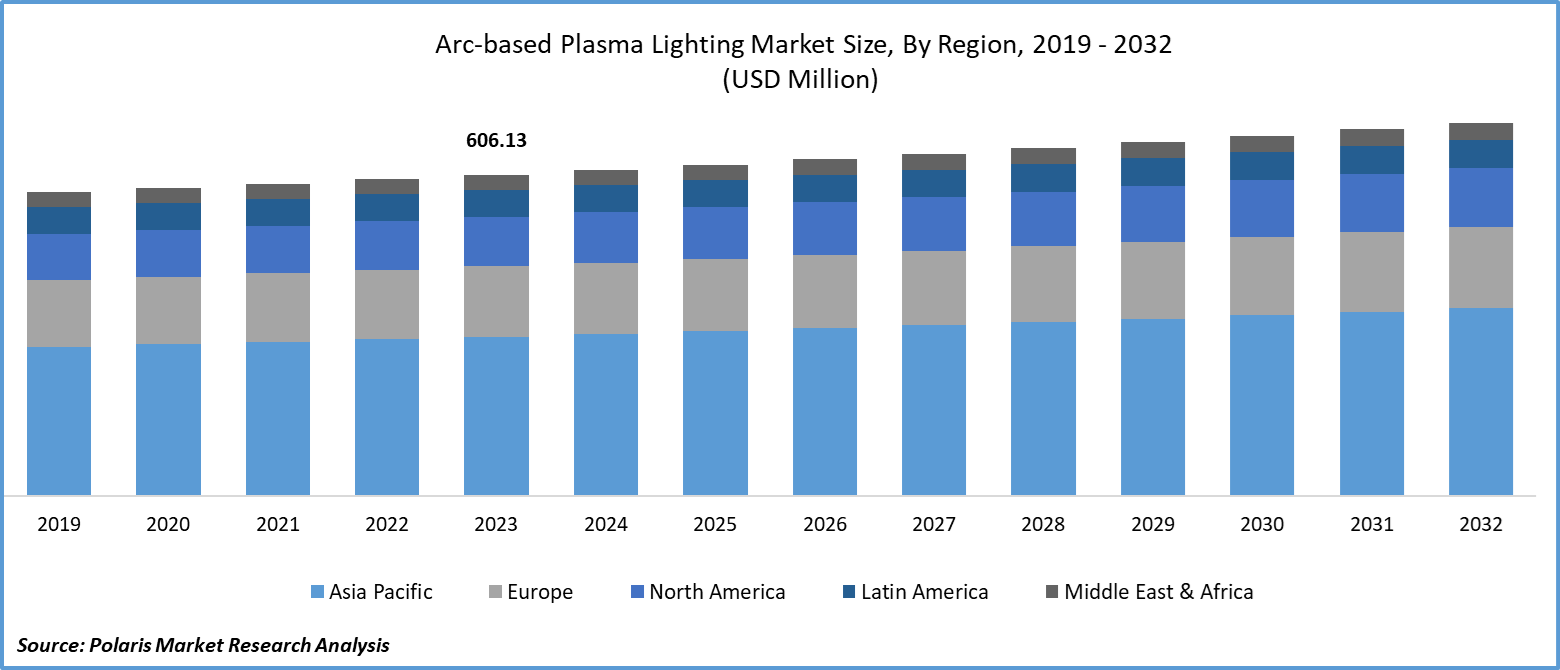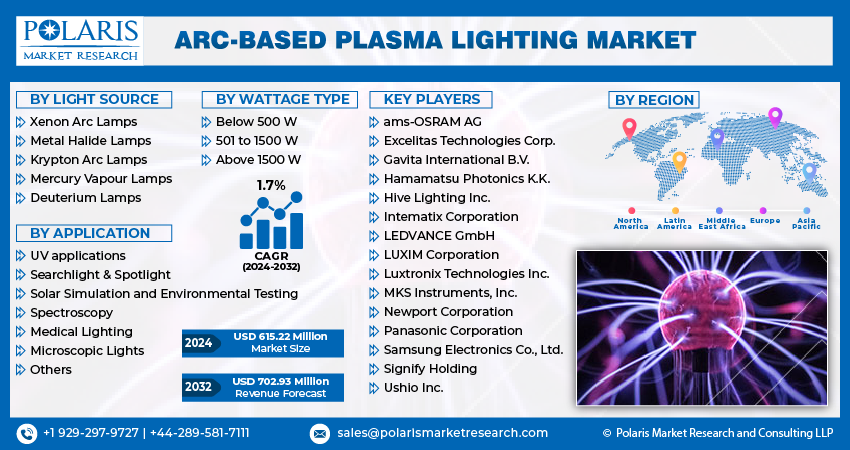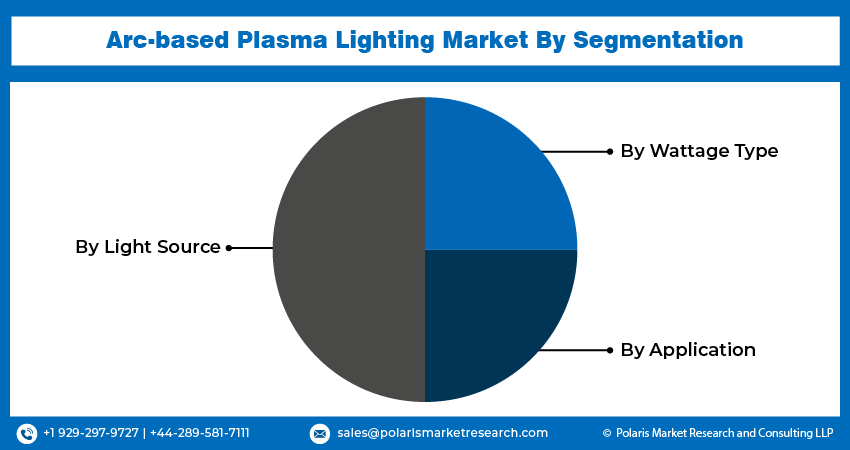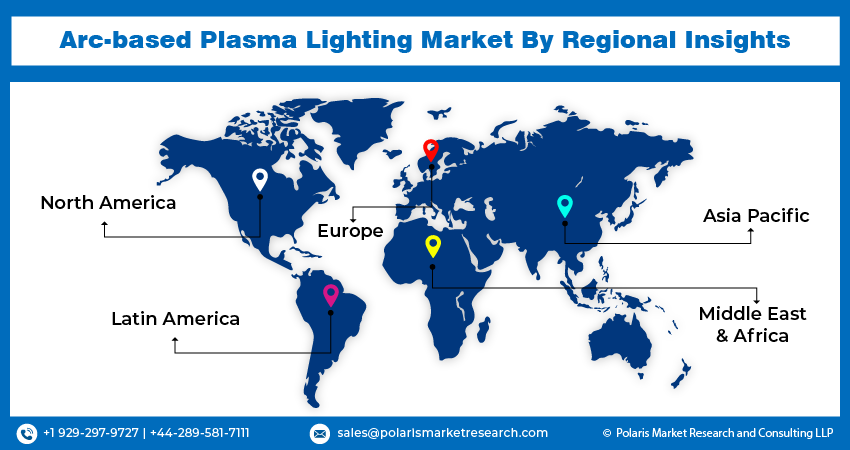
Arc-based Plasma Lighting Market Share, Size, Trends, Industry Analysis Report, By Light Source; By Wattage Type (Below 500 W, 501 to 1500 W, Above 1500 W); By Application; By Region; Segment Forecast, 2024 - 2032
- Published Date:May-2024
- Pages: 118
- Format: PDF
- Report ID: PM4905
- Base Year: 2023
- Historical Data: 2019-2022
Report Outlook
Arc-based Plasma Lighting Market size was valued at USD 606.13 million in 2023. The market is anticipated to grow from USD 615.22 million in 2024 to USD 702.93 million by 2032, exhibiting the CAGR of 1.7% during the forecast period
Arc-based Plasma Lighting Market Overview
Arc-based plasma lighting is a cutting-edge lighting technology that operates by generating light through an electrical current arc within a gas-filled bulb. This method stimulates plasma in the bulb, known for its efficiency, durability, and superior light quality, this technology is well-suited for a wide array of uses. The rising demand for energy-efficient and long-lasting lighting, coupled with government initiatives supporting plasma lighting control systems, is propelling the expansion of the arc-based plasma lighting market.
- For instance, in December 2023, Ushio Inc. and Dutch research and technology organization TNO have strengthened their partnership through a new five-year maintenance and collaboration agreement. Following a successful five-year period where Ushio was TNO's key supplier and partner for the high-intensity EUV light source in TNO’s EBL2 facility, this renewed collaboration highlights a dedication to ongoing innovation.

To Understand More About this Research:Request a Free Sample Report
The adaptability of plasma lighting in various industries, from agriculture for enhancing plant growth to industrial applications for top-notch illumination, is broadening the market's reach. Nevertheless, the market growth is hindered by the high costs and technical constraints linked to arc-based plasma lighting. Anticipated advancements in the enhancement of arc-based plasma lighting solutions to boost functionality and efficiency are poised to unlock growth opportunities in the market.
However, the reliability and durability of this technology make it capable of withstanding mechanical stress, ensuring its longevity even in challenging environments where traditional lighting sources may fail. Although arc-based plasma lighting offers notable advantages in terms of brightness and efficiency, it also presents environmental obstacles that impede its market expansion. A key concern revolves around the environmental impact linked to the manufacturing and disposal of lamps. The production process for arc-based plasma lamps commonly involves the utilization of materials like mercury, which, if not handled appropriately, can have detrimental effects on ecosystems and human health.
Arc-based Plasma Lighting Market Dynamics
Market Drivers
- Technological Advancements in Lighting Systems
The rapid development of lighting technology in recent years, especially in terms of the power efficiency of the light source, is largely attributed to advancements in technology. New high-intensity lightings are capable of providing high light output while consuming minimal power. The key to these advancements lies in the materials used in production, which have significantly improved efficiency. The use of a combination of organic and inorganic materials in the manufacturing of lighting reduces the number of required layers from four or five to just one, which lowers production costs but also simplifies the manufacturing process.
- Energy Efficiency Regulations and Sustainability Initiatives
LEDs are a type of lighting solution that is gaining popularity due to their sustainability. These lights are known as point source lights because they emit light from a small surface area, allowing for precise regulation and direction of light in LED lamps. Additionally, LED luminaires are cost-effective and have a longer lifespan. The effectiveness of a lamp in converting electrical energy into light is commonly measured by its 'luminous efficacy.' This parameter quantifies the amount of lumens produced per watt of power consumed. In general, a higher efficacy indicates a lower energy requirement for providing a specific lighting service.
Market Restraints
- Limited Awareness and Education among Consumers
Limited awareness and education among consumers regarding the arc-based plasma lighting market can be attributed to traditional lighting technologies, such as incandescent and fluorescent lamps have held a strong presence in the market for many years, leading to a lack of exposure to newer alternatives like arc-based plasma lighting. Moreover, promotional activities and educational initiatives focusing on this technology have been relatively scarce in comparison to more popular lighting choices. In the absence of sufficient information and comprehension of its advantages, such as energy efficiency, durability, and superior light quality, consumers may opt for familiar alternatives, thus perpetuating the cycle of limited awareness.

Report Segmentation
The market is primarily segmented based on light source, wattage type, application and region.
|
By Light Source |
By Wattage Type |
By Application |
By Region |
|
|
|
|
To Understand the Scope of this Report:Speak to Analyst
Arc-based Plasma Lighting Market Segmental Analysis
By Light Source Analysis
- The xenon arc segment led the market with substantial revenue share, largely attributed to its ability to offer an outstanding combination of characteristics and broad applicability across various industries. They have the ability to produce light that closely resembles natural sunlight, requiring accurate color reproduction like automotive lighting and cinema projection. The intense brightness makes them ideal for illuminating outdoor spaces in sizable locations. The proven durability and long lifespan of Xenon arc lamps enhance their applications in both industrial and commercial industries.
- The metal halide segment is projected to grow at a healthy CAGR during the projected period, mainly driven by its wide range of beneficial characteristics and features such as intense brightness, effectiveness, and color reproduction features, which render them appropriate for a wide array of uses like illuminating stadiums, powering automotive headlights, and lighting indoor commercial spaces. Continuous progress in metal halide lamp technology, such as enhancements in electrode structure, arc tube components, and ballast effectiveness, is elevating their efficiency and dependability, consequently fuelling market expansion. Additionally, the flexibility of metal halide lamps, coupled with their capacity to generate a broad spectrum of color temperatures and spectral emissions.
By Wattage Type Analysis
- The 1500 W dominated the market because it was specifically designed to meet the requirements of applications that demand extremely bright lighting, such as vast outdoor spaces, sports arenas, and industrial establishments. Additionally, advancements in technology have enabled the creation of plasma lighting products that are more efficient and dependable within this wattage range.
- The 501 to 1500 W segment in the arc-based plasma lighting market is projected to experience the CAGR during the forecast period owing to its wide range of applications, including large-scale outdoor lighting such as stadium illumination and street lighting, as well as industrial and commercial settings that require intense illumination. Furthermore, the 501 to 1500 W segment offers an emphasis on energy efficiency and sustainability, energy consumption, and cost-effectiveness.
By Application Analysis
- The UV segment is expected to grow at the fastest CAGR owing to the demand for UV light sources increasing in various industries, such as water and air purification, sterilization, and medical treatments, as health and hygiene concerns rise. Moreover, ongoing improvements in UV technology have resulted in the creation of more efficient and affordable plasma-based UV lighting systems, broadening their usage in different fields. Furthermore, the growing recognition of UV's disinfection capabilities, especially in healthcare facilities and public areas, is fueling the acceptance of UV-based solutions.

Arc-based Plasma Lighting Market Regional Insights
The Europe region dominated the global market with the largest market share
The Europe region dominated the global market with the largest market share and is expected to maintain its dominance throughout the forecast period as the European nations prioritize sustainability and energy efficiency, creating a demand for innovative lighting solutions such as arc-based plasma lighting, known for its high energy efficiency. Research and development in the region have led to the development of cutting-edge technologies and advancements in plasma lighting systems. Additionally, government policies and incentives supporting the adoption of energy-efficient lighting solutions have further boosted the market presence of arc-based plasma lighting in Europe. The presence of well-established lighting companies and a strong infrastructure for manufacturing and distribution are driving factors in Europe's dominance in this market.
The Asia Pacific region is poised to demonstrate the most significant growth rate in the market due to the rising demand for advanced lighting solutions in the medical field, specifically for surgical and diagnostic purposes, which is propelling the utilization of arc-based plasma lighting. Furthermore, the entertainment and projection sector, infrastructure, and automotive industry are experiencing rapid expansion, owing to the increasing consumer expenditures fueling the adoption of arc-based plasma lighting technology.

Competitive Landscape
The Arc-based Plasma Lighting market is fragmented and is anticipated to witness competition due to several players' presence. Major service providers in the market are constantly upgrading their technologies to stay ahead of the competition and to ensure efficiency, integrity, and safety. These players focus on partnership, product upgrades, and collaboration to gain a competitive edge over their peers and capture a significant market share.
Some of the major players operating in the global market include:
- ams-OSRAM AG
- Excelitas Technologies Corp.
- Gavita International B.V.
- Hamamatsu Photonics K.K.
- Hive Lighting Inc.
- Intematix Corporation
- LEDVANCE GmbH
- LUXIM Corporation
- Luxtronix Technologies Inc.
- MKS Instruments, Inc.
- Newport Corporation
- Panasonic Corporation
- Samsung Electronics Co., Ltd.
- Signify Holding
- Ushio Inc.
Recent Developments
- In January 2024, Excelitas Technologies Corp., a prominent manufacturer of industrial and medical technology dedicated to providing cutting-edge photonic solutions, announced the acquisition of the Noblelight business from Heraeus Group, with significant prospects to maximize their collective capabilities, ensuring optimal service to their valued customers and sustaining a rapid trajectory towards profitable expansion.
- In December 2023, Lumartix, a Swiss firm that focuses on plasma light engine technology, created a solar simulator for conducting characterization, aging, and stabilization tests, along with light-soaking and solar-simulation capabilities. The Solixon A-22 simulator is tailored to various PV technologies, such as thin-film and perovskite solar cells.
Report Coverage
The Arc-based plasma lighting market report emphasizes on key regions across the globe to provide better understanding of the product to the users. Also, the report provides market insights into recent developments, trends and analyzes the technologies that are gaining traction around the globe. Furthermore, the report covers in-depth qualitative analysis pertaining to various paradigm shifts associated with the transformation of these solutions.
The report provides detailed analysis of the market while focusing on various key aspects such as competitive analysis, light source, wattage type, application and their futuristic growth opportunities.
Arc-based Plasma Lighting Market Report Scope
|
Report Attributes |
Details |
|
Market size value in 2024 |
USD 615.22 million |
|
Revenue forecast in 2032 |
USD 702.93 million |
|
CAGR |
1.7% from 2024 – 2032 |
|
Base year |
2023 |
|
Historical data |
2019 – 2022 |
|
Forecast period |
2024 – 2032 |
|
Quantitative units |
Revenue in USD million/billion and CAGR from 2024 to 2032 |
|
Segments covered |
By Light Source, By Wattage Type, By Application, By Region |
|
Regional scope |
North America, Europe, Asia Pacific, Latin America; Middle East & Africa |
|
Customization |
Report customization as per your requirements with respect to countries, region and segmentation. |
FAQ's
The global Arc-based Plasma Lighting market size is expected to reach USD 702.93 million by 2032
Key players in the market are Hive Lighting Inc., Intematix Corporation, LEDVANCE GmbH, LUXIM Corporation, Luxtronix Technologies Inc
Europe contribute notably towards the global Arc-based Plasma Lighting Market
Arc-based Plasma Lighting Market exhibiting the CAGR of 1.7% during the forecast period
The Arc-based Plasma Lighting Market report covering key segments are light source, wattage type, application and region.
